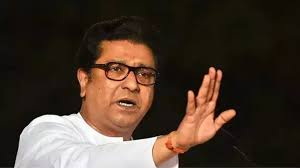Amid alliance buzz, why a shrunken Raj Thackeray may not be of much help to BJP, Sena (UBT) in civic polls

As Maharashtra gears up for its upcoming civic elections, all eyes are once again on the shifting political alliances that have long defined the state’s electoral landscape. One name that frequently emerges in discussions—but now with significantly less political weight—is Raj Thackeray, the supremo of the Maharashtra Navnirman Sena (MNS).
Despite the speculation of possible alignments between the MNS and larger political players like the Bharatiya Janata Party (BJP) or the Shiv Sena (UBT), many political analysts argue that Raj Thackeray’s current standing may offer little strategic value in terms of votes or influence.
Once a Firebrand, Now a Faded Force
Raj Thackeray burst onto Maharashtra’s political scene in 2006 with flair and fanfare, having broken away from his uncle Bal Thackeray’s Shiv Sena. Initially, the MNS managed to position itself as a bold, pro-Marathi alternative, attracting urban youth and disgruntled Shiv Sainiks.
The party’s most notable success came in the 2009 Maharashtra Assembly elections, where it won 13 seats and emerged as a potential kingmaker in Mumbai and Thane. However, in the years that followed, the MNS failed to consolidate its support base. A mix of erratic political posturing, inconsistency in ideological messaging, and an inability to expand beyond urban pockets led to its steady decline.
By the 2019 state elections, the MNS had become nearly irrelevant, failing to win even a single seat. Civic elections, once the arena where Raj’s party held some sway, now reflect the same dwindling influence.
Alliance Speculations: Who Needs Whom?
With civic polls around the corner, buzz around possible alliances is intensifying. For both the BJP, which is looking to strengthen its urban presence, and the Sena (UBT), which wants to reclaim its old strongholds, bringing in the MNS could appear tactically sound—at least on paper.
However, the ground reality is quite different.
The MNS has no significant electoral machinery left, limited cadre strength, and practically no grassroots connect outside a handful of wards in Mumbai and Pune. Any alliance with Raj Thackeray’s party is unlikely to yield a meaningful vote transfer, especially since voters now see MNS as a fringe player rather than a serious political contender.
Raj Thackeray’s Political Positioning: Confused and Contradictory
Another reason why the MNS may not be an asset is Raj Thackeray’s fluctuating political tone. One year, he takes a hard Hindutva stand, complete with Ayodhya visits and saffron flags; the next, he softens his rhetoric to appeal to Marathi secular voters. This inconsistency has eroded the trust of both core Marathi supporters and the broader Hindu nationalist base.
Political alliances are often built on shared narratives and ideological synergy. In MNS’s case, it’s unclear what ideological plank it truly represents anymore—making it difficult for either BJP or Sena (UBT) to project the alliance as coherent or credible.
Urban Voters Have Moved On
Mumbai, Thane, Pune, and Nashik were once considered MNS-friendly cities, with their educated Marathi middle class and youth-driven demographics. But urban voters have gradually shifted towards the BJP for governance and development, or back to Uddhav Thackeray’s Sena for identity politics with a moderate face.
MNS’s absence from active civic engagement and visible leadership in local bodies means that it no longer resonates with the urban electorate. In such a context, an alliance involving MNS could end up being more symbolic than substantial.
Why BJP Might Still Flirt with the Idea
Despite these realities, the BJP may still consider a limited seat-sharing understanding with the MNS. The goal would not be to gain votes but to cut into Sena (UBT)’s traditional Marathi vote base, especially in close contests. Even a few hundred votes can tilt results in tightly fought municipal wards.
Raj Thackeray’s name still evokes some emotional resonance among old-time Shiv Sainiks, and the BJP might be betting on this nostalgic appeal to erode Uddhav Thackeray’s support. However, this is a high-risk, low-reward strategy that could backfire if voters see it as mere opportunism.
What About Shiv Sena (UBT)?
For Uddhav Thackeray, aligning with Raj Thackeray would be an ideological and emotional stretch. The familial rift, differing political journeys, and conflicting ambitions have kept the two cousins apart for nearly two decades.
Any suggestion of a united Thackeray front may appeal to nostalgic Sena supporters, but it could also create internal tensions. Moreover, Sena (UBT)’s current allies—Congress and NCP (Sharad Pawar)—may oppose bringing in a wildcard like Raj Thackeray, who lacks a predictable political compass.
Conclusion: A Shrinking Star in a Crowded Sky
Raj Thackeray’s MNS has lost the political heft it once boasted. While he still manages to grab headlines with fiery speeches and controversial stands, his electoral relevance has nearly vanished. In the context of civic polls where ground-level organization and cadre strength matter more than charisma, Raj Thackeray offers little to either the BJP or Sena (UBT).
The idea of an MNS alliance might serve as a media distraction or a pressure tactic, but it is unlikely to impact the actual outcome in any meaningful way.
For the two major players, the real task lies in consolidating their urban machinery, refining their civic agendas, and re-energizing their voter bases—not in seeking an alliance with a political brand that may already be past its expiration date.






